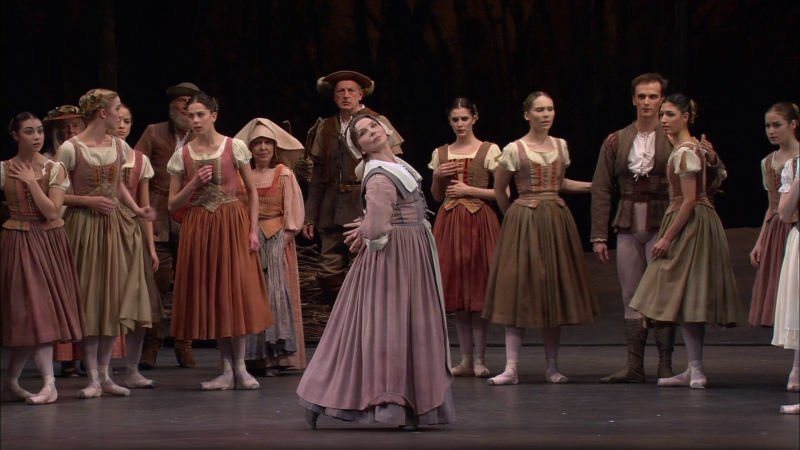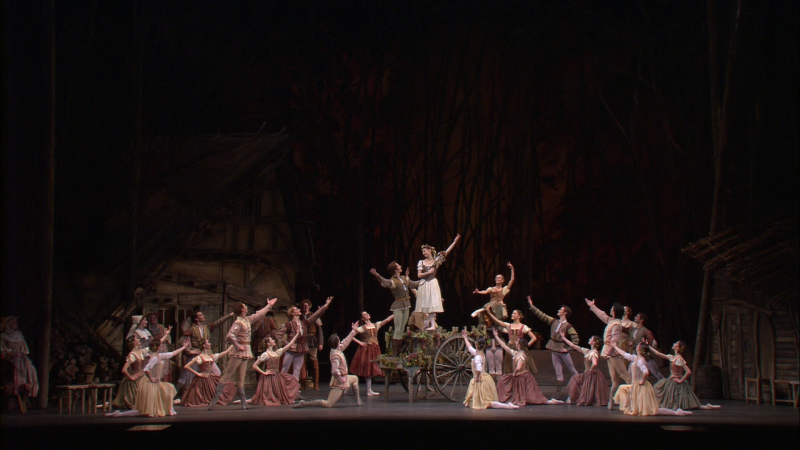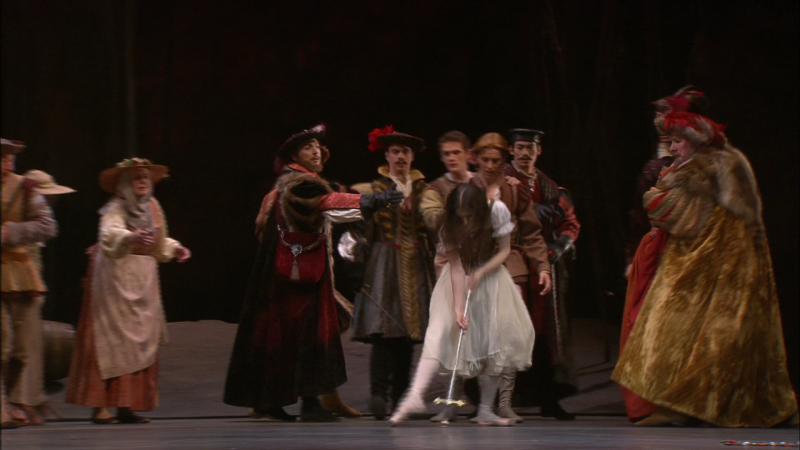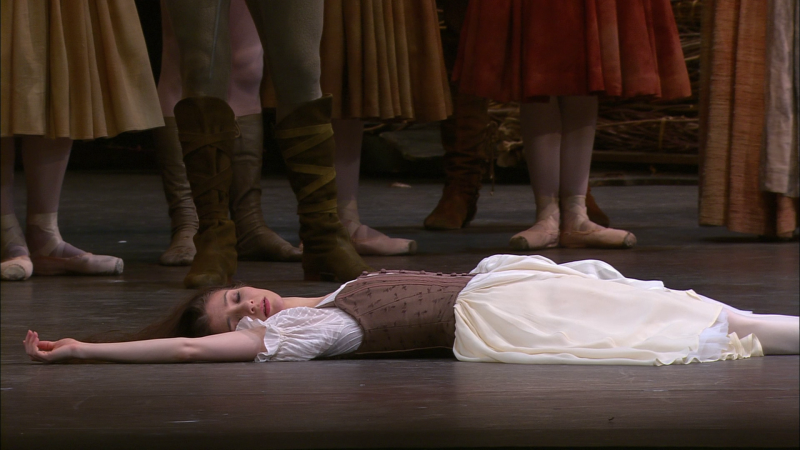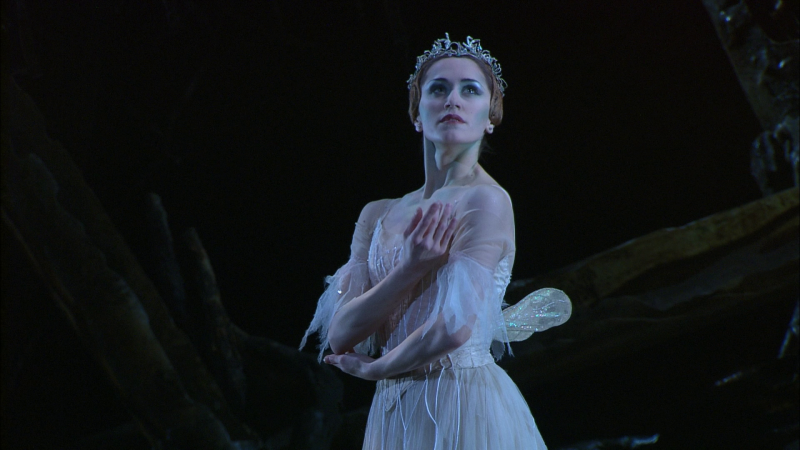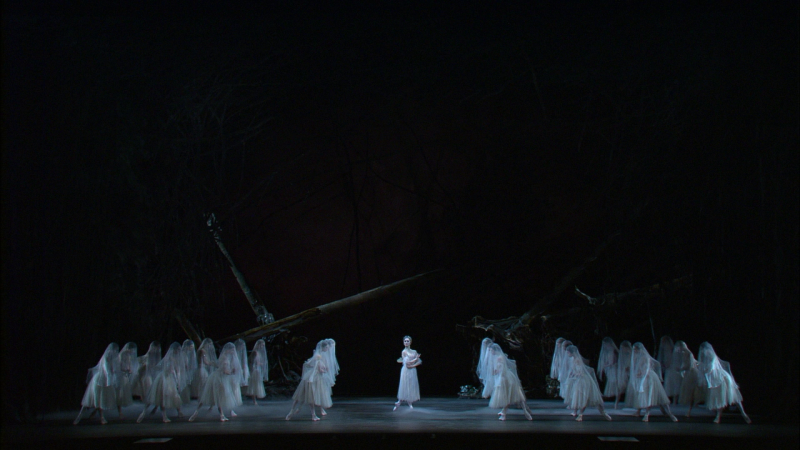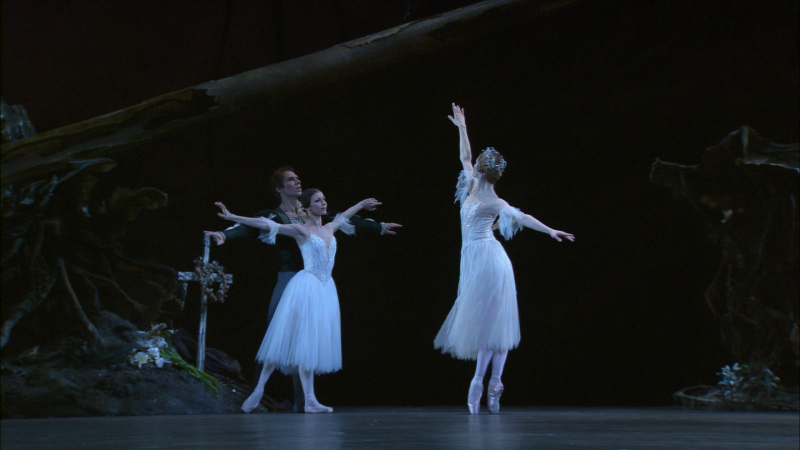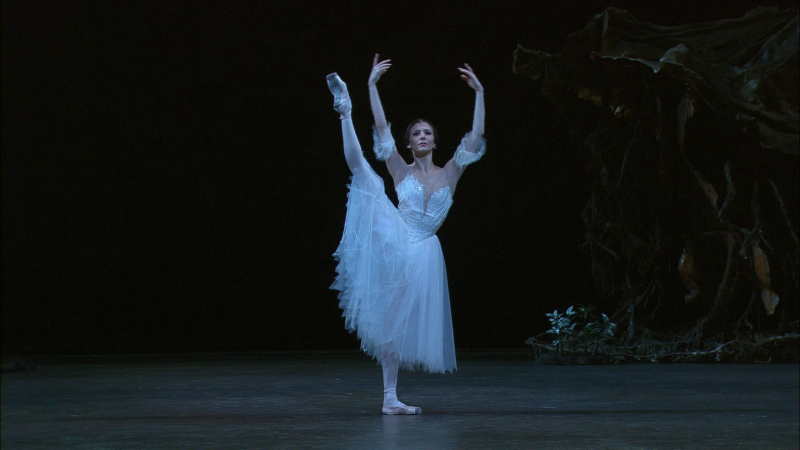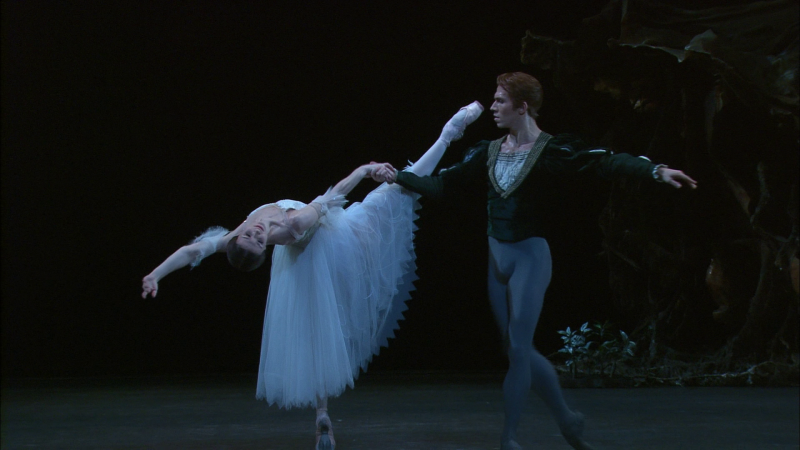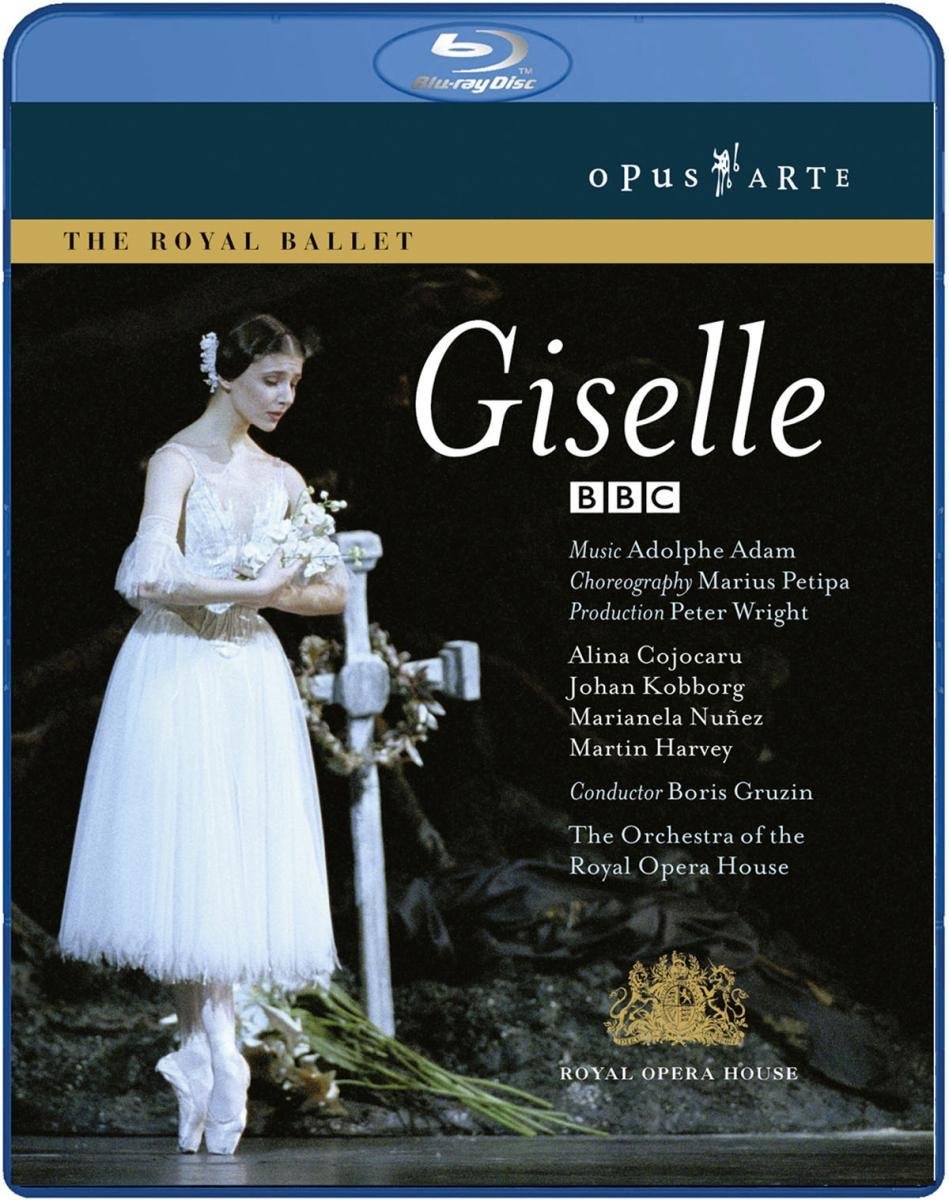

Giselle ballet. Music by Adolphe Adam to libretto by Jules-Henri Vernoy de Saint-Georges & Théophile Gautier. Choreography by Marius Petipa. Staged 2006 by Peter Wright at the Royal Opera House. Stars Alina Cojocaru (Giselle), Johan Kobborg (Count Albrecht), Marianela Nuñez (Myrtha), Martin Harvey (Hilarion), Richard Ramsey (Wilfred), Sandra Conley (Berthe), David Drew (Duke of Courland), Genesia Rosato (Bathilde), Alastair Marriott (Leader of the Hunt), Laura Morera, Ricardo Cervera, Gemma Sykes, Victoria Hewitt, Bennet Gartside, Kenta Kura (Pas de Six), Deirdre Chapman (Moyna), and Isabel McMeekan (Zulme) as well as artists of the Royal Ballet. Boris Gruzin conducts the Orchestra of the Royal Opera House (Concert Master Sergey Levitin). Design by John Macfarlane; lighting by Clare O'Donoghue based on Jennifer Tipton; staging by Christopher Carr. Directed for TV direction by Ross MacGibbon. Released 2009, disc has 5.0 PCM sound. Grade: A-
In February 2010 we had 3 Giselle HDVDs. First to be published was the Opus Arte 2009 Cojocaru/Kobborg/Nuñez version by the Royal Opera House ("ROH"). Later we got the TDK 2009 Pujol/Le Riche/Gillot version from the Paris Opera Ballet ("POB"). And finally we had a Kultur 2010 Tsygankova/Varga/de Jongh take with the Dutch National Ballet ("DNB"). This review, which I attach to all 3 versions, will present a shootout of these three titles.
In Act 1, we meet the tender, innocent peasant girl Giselle who is in love with the handsome Albrecht. Albrecht pretends to be a peasant youth, but he's really a nobleman who is engaged to a girl of his own class. Giselle's mother Berthe warns Giselle of the dangers of romance and tells Giselle about the Wilis, the ghosts of jilted girls who died before their weddings and who haunt the nearby forest. Hilarion, a peasant hunter who loves Giselle, is suspicious of Albrecht. When Hilarion reveals Albrecht's identity and his duplicity, Giselle goes mad and dies. Everyone is distraught, including Albrecht, who, we begin to understand, truly preferred Giselle to the noble lady with whom he has been matched.
In Act 2, Giselle has been buried in the forest. 26 Wilis and their Queen, Myrtha, prepare to receive Giselle as their latest initiate. Giselle will then help them accomplish their mission: to trap young men (whether guilty or innocent) and force them to dance until they die from exhaustion. Hilarion visits Giselle's grave and meets his doom. Albrecht also visits Giselle's grave and is captured by the Wilis. But Giselle rebels and protects her sweetheart just long enough for the dawn to arrive and disperse the Wilis. Albrecht escapes, but he must live out his life knowing that he will never see his true love again.
In Act 1, the ROH has the best mise-en-scène with updated sets, warm lighting, beautiful costumes, great acting, and coherent direction. Everybody in the cast, selected for acting ability or sex appeal as well as dancing prowess, seems 2 to 10 years younger than their French counterparts in the POB. Picture quality is excellent with vivid and skillful editing. The sound is adequate. Cojocaru is cute and charming. Her mad scene is deeply pathetic. She stabs herself and then dies hard, which means that she will be buried in the forest, and not in the churchyard, where those who commit suicide are not allowed. Sandra Conley is touching as Giselle's mother, Martin Harvey as Hilarion is appealing, and Johan Kobborg as Albrecht seems worthy of sympathy, especially after we meet his fiancée played haughtily by Genesia Rosato, who appears to be 5 to 10 years older than he.
In contrast, the approach of the POB to Act 1 is cooler and more formal. It features larger dancing formations—executed with impressive skill— that need full-stage photography. I get the impression that the sets and costumes have been packed and unpacked a great many times. Pujol is maybe a bit too old and mature to be the Giselle the girl, but she makes up for this with her assured dancing skills. For example, there is a scene where Giselle hops repeatedly on pointe on her left foot. Cojocaru does 24 small hops which are hardly noticable among all that is going on. But Pujol makes an almost unbelievable display of this with 34 big, bold hops that take her half across the stage while she laughs and flirts with all the spectators standing around gawking. The other stars are only OK. Picture quality is a bit disappointing, but the POB has the better sound with 7.1 dts-HD Master Audio.
The Kultur video was made from the first ever production of Giselle by the DNB. For the Dutch folks to compete with the ROH and the POB in this might be a bit like Lichtenstein getting into a soccer tournament with England and Brazil. The DNB forces obviously had a lesser budget than the others and their small forces looked rather thin on the big stage. On the other hand, Varga seemed to me to be the best Albrecht in this group. Kultur is entering the market at a lower price point than Opus Arte or TDK. This means Kultur has to cut corners—picture quality is only adequate and the "5.1 Dolby" sound is feeble when compared to the TDK disc.
Act 2 is a ghost story in ballet blanc. Now the tables are turned in favor of the formal approach of the POB. Marie-Agnès Gillot is commanding as Queen of the Wilis, a task that is too much to ask of the younger and shorter Nuñez. Pujol is prettier as as ghost than she was as a girl. The cool lighting of the POB is perfect now, with a mottled blue-white pattern that allows you to see well enough while preserving a sense of mystery. The blue light washes out the pink skin hues to the point that the dancers look as well as dance like spirits. At Myrta's command, the veils of all the jilted girls instantaneously fly offstage as if by magic. The cameras in Paris are positioned in the balconies where they look down on the stage and reveal the exact location, rank and file, of each dancer at every moment throughout all their formations. This gives us rolling proof of the discipline, control, and perfection for which the Paris female corps is famous. (If their formations were any more orderly, it would start to look like a computer simulation.)
In contrast, the cameramen in London shoot Act 2 from positions level with the stage. This they do, I think, in an (only partly successful) attempt to obscure irregularities and raggedness in the ROB ballet-blanc formations. This leaves the female corp of the POB in charge. But let's don't forget about the Dutch! Igone de Jongh is gorgeous and terrifying as Myrtha. Varga bests his competition in portraying Albert's grief. And the Dutch corps worked hard on their white formations, which are better than those of the ROH and almost as impressive as the work of the POB.
So here's how I sum up the 3 Giselles. Act 1 is a the story of a girl who died. Act 2 is a ghost story. The ROH focuses on the girl and has the best Act 1. The POB focuses on the ghosts and has the best Act 2. The DNB has only a fair Act 1, but they surpass the ROH and are competitive with the POB in Act 2. The prettiest scene in all three versions belong to the DNB when the corps circles Myrtha in the smoke at the beginning of Act 2. For young children and ballet newbies, the ROH disc will probably be more fun. For all others, the POB disc must be preferred because of it's admirable white scenes and superior sound. The DNB disc would be an option if you are in Region A, have an entry-level home theater, and you are on a tight budget.
Now let's consider some screenshots from the ROB Giselle. We start with a shot of Giselle's mother (Sandra Conley) and the forester Hilarion (Martin Harvey), who is in love with Giselle:
Giselle (Alina Cojocaru) is in love with the peasant Loys, who is really Count Albrecht (Johan Kobborg):
The harvest is over and the people of the village celebrate with many dances; here's a shot of some beautiful work from Laura Morera and Richard Cervera:
Giselle's mom, in a splendid pantomime, warns all the young people about strangers, ruined girls, and the Wilis, the dangerous ghosts of jilted girls who live in the nearby forest:
Giselle is crowned Queen of the harvest:
Royals out hunting ask for refreshments. The princess Bathilde (Genesia Rosato) is charmed by Giselle. Bathilde thinks that Giselle is soon to be married and gives her a fabulous necklace as a wedding present. Neither Bathilde nor Giselle realizes that they both expect to marry the same man:
But Hilarion has figured it all out. Enflamed by thwarted desire, he challenges Albrecht and blows the horn to call the hunting party back to Giselle's hut:
Giselle's happiness as harvest queen and bride-to-be does not last long. After Giselle sees Albrecht kiss the hand of the Princess, Giselle learns the truth—her sweetheart is a royal engaged to a Princess:
Giselle goes mad. She grabs a sword and threatens to kill herself. There is a wild scramble as the men take the sword away from her. But in the melee, Giselle is pierced through her bodice. There's no blood, but in a few moments, she collapses and dies:
Because of her suicide, Giselle is buried, not in the churchyard, but deep in the forest, where the Wilis reign at night. Here is Marianela Nuñez as Myrtha, Queen of the Wilis, and her court:
This image (out of order) shows the youth and beauty of the women of the female corps of the Royal Ballet:
But the corps is not as well-drilled as it could be. For example, in this view, three girls have one arm too low and one of them has her legs in the wrong position:
Giselle is the latest initiate to the order of the Wilis:
—
But Giselle still loves her Prince and appears to him when he visits her grave:
The death of Hilarion:
Albrecht is also captured by the Wilis also, but Giselle defends him:
Much to the confusion and dismay of all the Wilis:
Giselle's last pas de deux and her farewell to Albrecht, who escapes death as the sun rises:
OR



